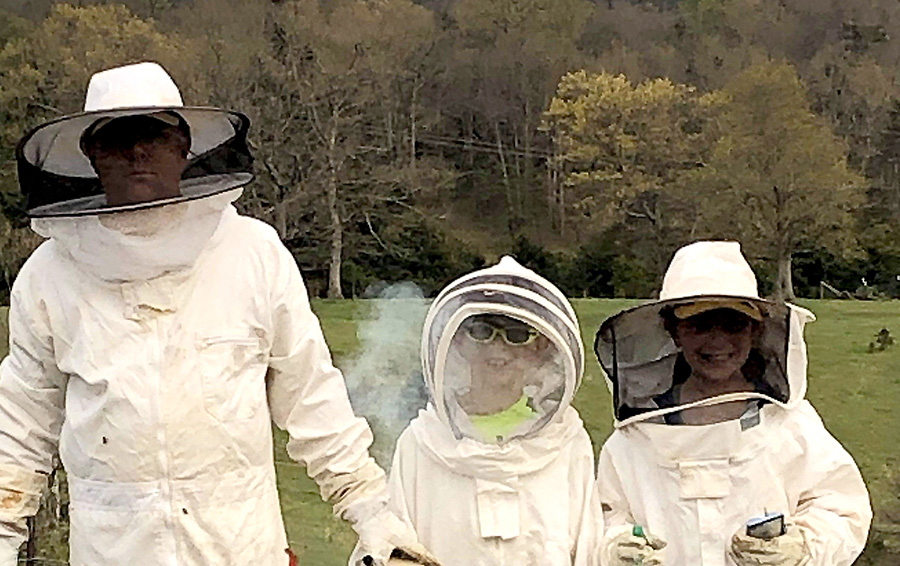The Yellow Jackets buzz around the field working together for victories, but Moorefield Softball assistant coach Jeremy Simmons has his own team of honey bees executing teamwork to build hives on the farm as his hobby as a beekeeper has been buzzing with activity for the past dozen years.
“Honey bee colonies are the ultimate team. Every bee in the hive has a job to do, and they work together to raise brood and to produce honey; they are the perfect team,” Hardy County Beekeeper Jeremy Simmons remarked.
“It is fun and rewarding to open the hive and just watch different things happening within the hive. Bees are bringing in pollen and nectar to make honey; bees are taking care of the queen; bees are caring for the eggs and larvae. Before bees swarm, they send out scout bees out to find a new, suitable place for the swarm to live. Those are just some of the things you will see if you look inside.”
Running across the softball outfield one could stomp on a honey bee which brings a reminder to the children’s song about squishing a baby bumblebee and how proud mommy would be.
Simmons recalls accidentally stepping on honey bees as a child dashing through a field and over the past decade seeing the disappearance of the bees gave him an idea to become a beekeeper to help rejuvenate the species and the vegetation on his farm.
“When I was a kid, I used to go barefoot in the summer, and I would often accidentally step on honey bees that were on clover in the yard. About 12 years ago I noticed that there weren’t any bees on the clover, and at about the same time I noticed a decline in the yield we were getting from our garden, our fruit trees, and from our berry vines; that’s when I decided to try beekeeping,” Simmons commented.[private]
Simmons wasn’t concerned about being stung as honey bees are rather docile creatures that only sting when provoked to protect the queen and hive much akin to the Yellow Jackets menacingly defending the Hive from Cougars attacking or a home owner fending off an intruder.
“I have never been afraid of being stung by the honey bees. It happens occasionally, but usually only after I’ve provoked them. Imagine someone was breaking into your house and stealing the food that you have worked hard to produce. Your natural reaction would be to protect your home; that’s how the bees must feel. For the most part, they only sting to protect their home and their colony. Kind of like people, some colonies are more defensive than others,” Simmons said.
Simmons took up beekeeping as a hobby adding to a long list of activities with three children learning various skills from sports to 4-H activities.
Simmons is a history teacher and has been coaching and umpiring in Little League, officiating youth to high school football and is currently one of the assistant MHS Softball coaches in addition to working in 4-H programs and other events.
“With our kids’ activities and our activities, beekeeping has always been just a hobby, but this year, with the cancellation of spring sports and the closing of schools, we have been able to dedicate more time to bees and hives,” Simmons noted.
Simmons is a history teacher at Moorefield Middle School and has discovered a plethora of learning aspects from being a beekeeper and the lessons can be applied to the online curriculum during the current pandemic.
“Hard work pays off. You can accomplish more by working together than you can by working on your own and against each other. There are also many science lessons in a hive. Their society is a pretty good model to follow, and we always keep records and journal when working with our hives. The hives provide us with great outdoor classrooms,” Simmons explained.
Scientifically speaking, the American honey bee is called the Apis Mellifera and there are variations of the name depending on where it is from and a beekeeper is also called an Apiarist.
Simmons used a batch of Italian honey bees when initially starting his beekeeping hobby and one can only imagine them saying ‘this is my hive, capisce’ and the success of this species helped him decide to use them again.
“The scientific name for the honey bee that we have in America is Apis mellifera. Apis mellifera is one of eight species of honey bees. I have had a couple of different types of honey bees in the past. When I began, I didn’t know how to get honey bees locally, so I could a place online and ordered a ‘package’ of Italian honey bees (Apis mellifera ligustica). The package of about 3,000 bees and a queen came through the U.S. Mail. The post office called the morning that it arrived, and I went and picked it up. Later that evening we installed the package. The original packages of bees built up and sustained for several years. I sought advice from people in Illinois that I brought them from. It was a good guide, but what works best for bees and beekeepers in the Mid-West doesn’t necessarily work best for bees and beekeepers in West Virginia. Another time, I bought bees from a beekeeper in southern Virginia. Those were Carniolan honey bees (Apis mellifera arnica). One of the benefits of the Carniolans was that they built up very fast in the spring. In fact, they built up too fast and I couldn’t keep ahead of the swarms; they swarmed all summer long. In fact, one of the largest swarms that I have ever captured came from those bees. Today, the bees that we have are Italian. They are gentle; they have a good brood pattern, and they are great honey producers. If I need bees these days, I either get them from swarms that I capture, splits that I make in my own hives in the spring, or if I need to purchase them, I purchase them from another local beekeeper,” Simmons commented.
There are many agricultural benefits which can be credited to honey bees and Simmons has enjoyed the yields from the work those bees do each year.
“Plants, trees, and flowers need pollinators such as honey bees. I have seen greater yield in our garden crops, wild berries, and in the spring our fruit and flowering trees are full with the hum of bees. Our hives provide pollination benefits to the whole neighborhood,” Simmons said.
This past week, Simmons and his family discovered a giant hive on a low tree branch and worked to move it into a box to cultivate the honey over time.
Wildflowers planted in the yard and other plant life have been a good source for the honey bees to cultivate honey.
“We have planted some wildflowers, rose bushes and butterfly bushes for the bees. We also have many plants that grow naturally in our area that are great honey producers for bees. Early in the spring even before we notice flowers and trees budding, we can watch bees coming into the hives with pollen on them. Locus bloom is a great honey producer. One of the things that I do to help the bees is I cut the lawn less. When I need to sew grass seed on bare patches, I use clover instead of lawn grasses. Some of the plants that most people see as nuisance are beneficial to bees and make great honey; thistles and catnip are two plants that I often let go,” Simmons commented.
The setup on the Simmons estate is perfect for their honey bees so they don’t have to fly too far to get what is needed for the hive and some bees could travel a couple miles to find plants or water.
When one thinks of a beekeeper, there are thoughts of the giant suits with the mesh masks which seem like an alien invasion or a a hazmat unit approaching the hive.
Simmons actually prefers not to wear the suit, but certain aspects of maintaining a hive does require the cumbersome and hot attire.
“I really don’t like to wear the suit, especially in the summer; it is really hot. Wearing the suit depends a lot on what I am doing with the hive. If I am just doing a quick check, pulling a couple of frames, feeding them sugar waterer adding a honey super (box), then I often don’t wear the suit. If I am gathering honey, splitting hives, moving hives, or capturing swarms, I wear it. I laugh at my kids (Thomas and Grace) when they wear their suits because the suits are too big; it make them look like E.T. in the movie when he was trick-or-treating,” Simmons remarked.
“The bee suits are not sting proof. They can sting through the suit sometimes, but it is usually not as bad as without the suit because the stinger gets caught in the suit and not in your skin. It is important to stay calm…I was stung 13 or 14 times while trying to capture a very large swarm. I just had to grin and bear it.”
On occasion, bees find ways to enter the suit and that can create unique moments during the beekeeping process.
“One of the funniest things that has happened was the time one got in and stung me right on the tip of the nose. My kids thought that was great,” Simmons noted.
This beekeeping hobby for the Simmons family fluctuates in size with the current number of hives at eight total (found two within past week), but there have been as many as a dozen at times over the years. A large hive weighs at around 60-80 pounds and could have as many as 80,000 bees.
“We currently only have six hives. We have had as many as 12, but with sports and other activities, that was too many for us to properly manage at the time. This year without school, sports, and other activities, we could have handled more. The average weight depends on how many bees and how much honey is in each box. When it is full the hive body (large super) weights about 60-80 lbs. Generally, a full honey super weighs around 40 lbs. Honey weighs more than brood (eggs, larvae). What we do is add honey supers to each hive as needed. I try to keep the number of boxes limited so they are easier to work with. If one gets full of honey, I take it and replace it with an empty one for the bees to work on filling. The number of bees in each hive depends on its strength. A typical hive has somewhere between 10,000 and 80,000 bees, sometimes more. The more bees there are in the late summer/early fall, the better the chance of that hive being able to survive over winter,” Simmons explained.
Beekeeping can be labor intensive depending on the size of the operation, but for Simmons it is a small hobby that produces honey for his family and friends and a typical yield is between five to 20 gallons.
“We have a small hobby bee operation, so the amount of labor isn’t tremendous. We try to open and check each hive about one a week or at least every other week. During a normal year when spring sports are in session, we can’t always do that, but this year we have had plenty of time to dedicate to our hobby farm, not just bees, but also goats, pigs, and chickens,” Simmons stated.
“We use a good bit of honey ourselves. I have sold it in the past, but I don’t really keep bees to make money. We enjoy sharing with friends and neighbors if we have plenty. We didn’t get much last year, so we ran out; I hope this year is better. Each of our honey supers will provide about one to one and a half gallons of honey. We usually get somewhere between five and 20 gallons of honey. Of course we don’t take it all, we try to leave at least 50 pounds of honey for the bees to eat over the winter,” Simmons noted.
Simmons didn’t know anything about beekeeping in the beginning and his knowledge of the topic was self-taught and now knows just enough to keep the hives buzzing with a positive mindset (MHS Softball motto).
“When I started beekeeping I knew nothing. Now I know just a little bit more than that. When I began, I don’t know other beekeepers in the area, so I sued books and online resources to self-educate. It was a trial and error operation, but our first few hives survived in spite of us. Since then, I have several other beekeepers that I go to when I have questions or notice strange behaviors in the hive. I have never met a beekeeper that didn’t want to help someone else learn about bees. Our local beekeepers are a great resource. After 10 or 11 years, I still learn something new almost every time I open a hive,” Simmons said.
Shaking a tree branch when there is a hive there isn’t recommended as chaos will ensue and chances are that individual doing that act will pay for the intrusion and for beekeepers they have to do their best with slow movements and smokers to coax the hive into the box.
“Generally, the bees are pretty calm when when they swarm; they just look intimidating. We use the smoker and sugar water in a spray bottle to help them as well. But…as you can imagine, after that first shake of the limb, all heck breaks loose, there are bees everywhere. It is a lot of fun, and can provide quite a rush,” Simmons remarked.
It has been a family hobby working as beekeepers and has been fun for each member of the family.
“My kids do enjoy working with the bees. This is really the first year that Grace and Thomas have helped much. They have enjoyed checking the hives and capturing the swarms this spring. Alyson has always helped in the past. She helped install the first bees when she was five or six years old and has helped since. This year, she usually is our runner and photographer. My wife, Stephanie, helps a lot too. She is a runner, photographer, and sometimes puts on the suit and helps me work the hives. She is our honey extractor and bottler. It has turned into a rewarding hobby in which everyone in our home participates,” Simmons commented.
Simmons remarked how the honey bees don’t listen to him much at all compared to the softball team as they are self-sustaining and pretty much know their job in the hive so he is far from a bee whisperer.
“Players listen better. The bees listen more like my own kids. I am not even close to being a ‘bee whisperer’. I try to provide them with what they need (new boxes to store honey and to raise brood, vaccinations and treatments, food in the form of candy boards that I make in the winter and sugar water in late winter/early spring and through the fall to help supplement the honey that they produce). Sometimes, even with all of that, the colonies still fail. Other times, they survive and thrive in spite of me. The bees are pretty self-sustaining…the stronger they stay, the more likely their survival,” Simmons concluded.[/private]
Simmons has a swarm of Yellow Jackets and honey bees in hives both on the softball field and at the farm working together to build successful outcomes.


